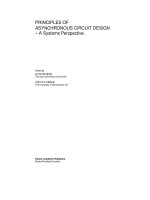Tài liệu Challenges of Cold Temperatures on OSP Cable Assemblies for FTTP ppt
Bạn đang xem bản rút gọn của tài liệu. Xem và tải ngay bản đầy đủ của tài liệu tại đây (242.35 KB, 5 trang )
Challenges of Cold
Temperatures on
OSP Cable Assemblies
for FTTP
WHITE PAPER
Introduction
Fiber-to-the-premise (FTTP) architectures are presenting both new challenges and
new opportunities regarding the use of connectors in the outside plant (OSP). At
no other time have connectors been as necessary in OSP architectures – and they
are destined to become even more prevalent in the days ahead as the FTTP
networking market continues to gain momentum. Service providers competing for
the FTTP market require the same flexibility in test access and the ability to
provision that they have typically enjoyed in the central office. They need to scale
service in a cost-effective manner.
Splicing is expensive and, since it is basically hard-wiring, is not very flexible.
Therefore, to achieve the flexibility required for FTTP networks, it simply makes
sense to use connectors at several key points of the network architecture. So for
the first time, network architects will be using more connectors – and cable
assemblies with connectors attached – to gain the best flexibility for the OSP
portions of their FTTP networks. This creates some significant challenges for
connectors, particularly their effectiveness in harsher outside environments.
Challenges of Cold Temperatures
on OSP Cable Assemblies for FTTP
Challenges of cold temperatures on OSP cable assemblies for FTTP
Page 3
Connectors in the OSP
Meeting the unique challenges of FTTP requires the
production of components that are cost effective, yet still
perform to OSP standards under austere temperature
conditions. In this paper, ADC will address one important
performance measurement issue for outside plant (OSP)
cable assemblies – how well they can adapt to cold
temperatures.
Insertion loss (IL) failures, for instance, are a direct result of
cable and cable assembly component shrinkage due to
low temperatures. If this shrinkage isn’t somehow
addressed in the manufacturing process, the optical fibers
can eventually break. ADC assemblies are designed to
overcome the challenges of low temperature effects and
the associated problems. Through proven manufacturing
techniques, these assemblies prevent shrinkage and the
problems – including fiber breakage – that can otherwise
result.
The environmental operating requirements for cable
assemblies in the North American market are defined by
industry standards. Telcordia GR-326, Issue 3, requires
cable assemblies to be subjected to two one-week thermal
cycle tests from -40 degrees C to +75 degrees C 21 times.
Each temperature extreme is held for a minimum one-hour
period, at which time the insertion loss and return loss are
measured. To meet the GR-326 requirement, insertion loss
cannot change more than 0.3dB at any time during the
test. Telcordia GR-20 defines similar requirements for non-
terminated OSP cable. The minimum operating
environment in this standard is also -40 degrees C.
Cold Temperature Challenges
Exposing cable and cable assemblies to low temperatures
is typically the most common cause of insertion loss
failures in OSP architectures. Figure 1 shows a typical
ribbon OSP cable assembly at normal temperatures. But as
temperatures approach -40 degrees, the thermoplastic
components in the cable breakout, jacketing, and fiber
fanout sections will tend to shrink more than the optical
fiber. These are the potential problem areas that are
addressed in this paper.
As temperatures decrease to -40 degrees, the effect on the
cable assembly becomes significant as it begins to shrink.
The optical fiber in the cable, however, remains at its
original length. This can cause the optical fiber to bunch
up inside the temporarily shortened assembly, causing
microbends and high insertion loss at 1550 nm.
The bends generally recover once the cable assembly is
brought back to room temperature. This failure mode
normally occurs in two places – the cable breakout (the
point at which the ribbons break out of the OSP cable),
and the fiber fanout (the point where the ribbons break
out into individual fibers).
Fiber fanout splits the ribbons into individual fibers and up-
jackets them to .900mm for termination to the fiber with
a connector. Because it is made of plastic, the .900mm up-
jacket tube shrinks more than the optical fiber at -40
degrees. Since the optical fiber itself does not bend inside
this tube, it will “piston” back into the fiber fanout
housing because the .900mm up-jacket tube is smaller.
A typical fiber fanout failure caused by cold temperatures
is shown in Figure 3.
Figure 3 shows the housing with the cover removed.
However, with the cover in place, severe bending will
occur as the fibers are pushed back into the open space of
the fiber fanout. In this particular non-ADC example, all 12
fibers broke at -40 degrees.
OSP
Cable
Cable
Breakout
Ribbons
Ribbon up
Jacketing
Fiber
Fanout
OSP
Cable
Cable
Breakout
Ribbons
Ribbon up
Jacketing
Fiber
Fanout
OSP
Cable
Cable
Breakout
Up-jacketed Ribbons
.900mm
Up-jacketed Fibers
Fiber
Fanout
Figure 2: The OSP cable assembly is shown at room
temperature (above) and cold temperature (below). Since the
cable assembly tends to shrink while the optical fiber remains
at its original length, microbends and high insertion loss result.
Figure 3: A typical fiber fanout failure shown with the housing
cover removed. In this non-ADC example, every individual fiber
broke under the stress caused by the shrinking jacket tube.
A similar problem occurs at the cable breakout point
where the ribbons are split out of the cable. At -40
degrees, the entire OSP cable will shrink up to 5% as
allowed by GR-20. Again, since the ribbons do not shrink
relative to the plastic cable components, they will bend
within the cable breakout, causing microbends and
insertion loss problems as they approach -40 degrees. A
failure similar to that depicted in Figure 2 can occur.
ADC’s Cold Temperature Solution
ADC’s ribbon OSP cable assemblies are designed with
special features that enable them to endure temperature
changes without failure and meet all GR-326 requirements
at -40 degrees C. This is accomplished by selecting low-
shrink plastic components and filling the fiber fanout and
cable breakout sections with a silicone adhesive. This
process prevents the fibers from being pushed into an
open space where bending can occur.
Since the .900mm up-jacketing has a small inside
diameter, bending will not occur. The fiber is effectively
under a small amount of compression because the
.900mm tubes will shrink about 1% at -40 degrees.
However, since there are no open spaces for the fiber to
bend – in neither the .900mm tube or the fiber fanout –
insertion loss remains low.
Fiber bend is similarly prevented at the cable breakout
point. The ribbons are prevented from bending in the
cable breakout housing because it is also filled with
silicone adhesive. This procedure forces any excess ribbon
length caused by low temperatures to be taken up within
the OSP cable. Inside the OSP cable, there is adequate
room for the ribbons to adjust at -40 degrees.
Summary
To summarize, ADC OSP cable assemblies meet the
insertion and return loss requirements of GR-326 at low
temperatures for the following three reasons:
• ADC only uses optical cable that is GR-20 compliant;
• ADC’s optical connectors meet the requirements of GR-
326, Issue 3; and
• ADC deals with the issues surrounding cable assembly
components at -40 degrees C.
Components used to construct OSP cable assemblies are
typically made of plastic and, therefore, tend to shrink at
cold temperatures. ADC’s cable assemblies are factory
designed to compensate for cold temperature shrinkage –
preventing microbends, high insertion loss, and fiber
breakage at -40 degrees C.
Challenges of cold temperatures on OSP cable assemblies for FTTP
Page 4
ADC Telecommunications, Inc., P.O. Box 1101, Minneapolis, Minnesota USA 55440-1101
Specifications published here are current as of the date of publication of this document. Because we are continuously
improving our products, ADC reserves the right to change specifications without prior notice. At any time, you
may verify product specifications by contacting our headquarters office in Minneapolis. ADC Telecommunications,
Inc. views its patent portfolio as an important corporate asset and vigorously enforces its patents. Products or
features contained herein may be covered by one or more U.S. or foreign patents. An Equal Opportunity Employer
1314221 05/05 Revision © 2004, 2005 ADC Telecommunications, Inc. All Rights Reserved
Web Site: www.adc.com
From North America, Call Toll Free: 1-800-366-3891 • Outside of North America: +1-952-938-8080
Fax: +1-952-917-3237 • For a listing of ADC’s global sales office locations, please refer to our web site.
WHITE PAPER









